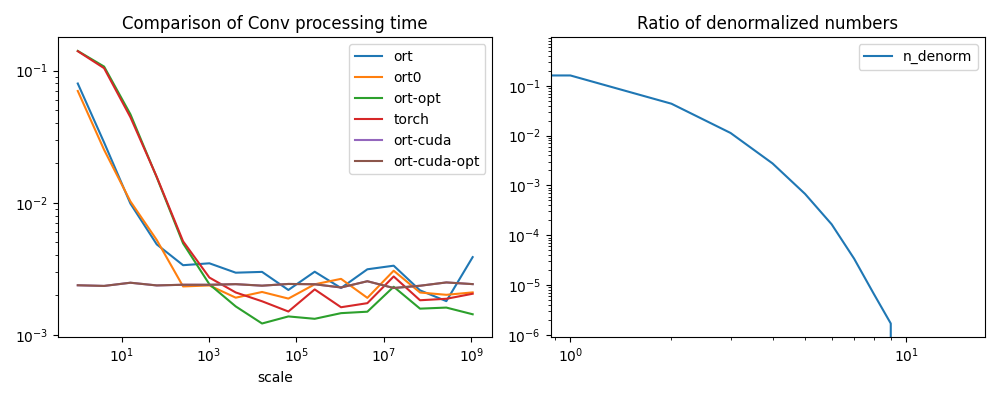Note
Go to the end to download the full example code.
How float format has an impact on speed computation¶
An example with Conv. The floats followed the IEEE standard Single-precision floating-point format. The number is interprated in a different whether the exponent is null or not. When it is null, it is called a denormalized number or subnormal number. Let’s see their impact on the computation time through the operator Conv.
Create one model¶
import struct
import matplotlib.pyplot as plt
from pandas import DataFrame
from tqdm import tqdm
import numpy
from onnx import TensorProto
from onnx.helper import (
make_model,
make_node,
make_graph,
make_tensor_value_info,
make_opsetid,
)
from onnx.checker import check_model
from onnx.numpy_helper import to_array, from_array
from onnxruntime import (
InferenceSession,
get_available_providers,
OrtValue,
SessionOptions,
GraphOptimizationLevel,
)
from onnx_array_api.plotting.text_plot import onnx_simple_text_plot
from onnx_extended.ext_test_case import measure_time, unit_test_going
from onnx_extended.reference import CReferenceEvaluator
try:
import torch
except ImportError:
# no torch is available
print("torch is not available")
torch = None
DIM = 64 if unit_test_going() else 256
def _denorm(x):
i = int.from_bytes(struct.pack("<f", numpy.float32(x)), "little")
i &= 0x807FFFFF
return numpy.uint32(i).view(numpy.float32)
denorm = numpy.vectorize(_denorm)
def create_model():
X = make_tensor_value_info("X", TensorProto.FLOAT, [1, DIM, 14, 14])
Y = make_tensor_value_info("Y", TensorProto.FLOAT, [None, None, None, None])
B = from_array(numpy.zeros([DIM], dtype=numpy.float32), name="B")
w = numpy.random.randn(DIM, DIM, 3, 3).astype(numpy.float32)
# let's randomly denormalize some number
mask = (numpy.random.randint(2, size=w.shape) % 2).astype(numpy.float32)
d = denorm(w)
w = w * mask - (mask - 1) * d
W = from_array(w, name="W")
node1 = make_node(
"Conv", ["X", "W", "B"], ["Y"], kernel_shape=[3, 3], pads=[1, 1, 1, 1]
)
graph = make_graph([node1], "lr", [X], [Y], [W, B])
onnx_model = make_model(graph, opset_imports=[make_opsetid("", 18)], ir_version=8)
check_model(onnx_model)
return onnx_model
onx = create_model()
onnx_file = "plot_op_conv_denorm.onnx"
with open(onnx_file, "wb") as f:
f.write(onx.SerializeToString())
The model looks like:
print(onnx_simple_text_plot(onx))
onnx_model = onnx_file
input_shape = (1, DIM, 14, 14)
opset: domain='' version=18
input: name='X' type=dtype('float32') shape=[1, 256, 14, 14]
init: name='W' type=float32 shape=(256, 256, 3, 3)
init: name='B' type=float32 shape=(256,)
Conv(X, W, B, kernel_shape=[3,3], pads=[1,1,1,1]) -> Y
output: name='Y' type=dtype('float32') shape=['', '', '', '']
CReferenceEvaluator and InferenceSession¶
Let’s first compare the outputs are the same.
sess_options = SessionOptions()
sess_options.graph_optimization_level = GraphOptimizationLevel.ORT_DISABLE_ALL
sess1 = CReferenceEvaluator(onnx_model)
sess2 = InferenceSession(onnx_model, sess_options, providers=["CPUExecutionProvider"])
X = numpy.ones(input_shape, dtype=numpy.float32)
expected = sess1.run(None, {"X": X})[0]
got = sess2.run(None, {"X": X})[0]
diff = numpy.abs(expected - got).max()
print(f"difference: {diff}")
difference: 3.814697265625e-05
Everything works fine.
Time measurement¶
CReferenceEvaluator: 0.251823739700194s
InferenceSession: 0.062200054199638546s
Plotting¶
Let’s modify the the weight of the model and multiply everything by a scalar. Let’s choose an random input.
has_cuda = "CUDAExecutionProvider" in get_available_providers()
X = numpy.random.random(X.shape).astype(X.dtype)
def modify(onx, scale):
t = to_array(onx.graph.initializer[0])
b = to_array(onx.graph.initializer[1]).copy()
t = (t * scale).astype(numpy.float32)
graph = make_graph(
onx.graph.node,
onx.graph.name,
onx.graph.input,
onx.graph.output,
[from_array(t, name=onx.graph.initializer[0].name), onx.graph.initializer[1]],
)
model = make_model(graph, opset_imports=onx.opset_import, ir_version=onx.ir_version)
return t, b, model
scales = [2**p for p in range(0, 31, 2)]
data = []
feeds = {"X": X}
expected = sess2.run(None, feeds)[0]
if torch is not None:
tx = torch.from_numpy(X)
sess_options0 = SessionOptions()
sess_options0.graph_optimization_level = GraphOptimizationLevel.ORT_DISABLE_ALL
sess_options0.add_session_config_entry("session.set_denormal_as_zero", "1")
for scale in tqdm(scales):
w, b, new_onx = modify(onx, scale)
n_denorm = (w == denorm(w)).astype(numpy.int32).sum() / w.size
# sess1 = CReferenceEvaluator(new_onx)
sess2 = InferenceSession(
new_onx.SerializeToString(), sess_options, providers=["CPUExecutionProvider"]
)
sess3 = InferenceSession(
new_onx.SerializeToString(), providers=["CPUExecutionProvider"]
)
sess4 = InferenceSession(
new_onx.SerializeToString(), sess_options0, providers=["CPUExecutionProvider"]
)
# sess1.run(None, feeds)
got = sess2.run(None, feeds)[0]
diff = numpy.abs(got / scale - expected).max()
sess3.run(None, feeds)
got0 = sess4.run(None, feeds)[0]
diff0 = numpy.abs(got0 / scale - expected).max()
# t1 = measure_time(lambda: sess1.run(None, feeds), repeat=2, number=5)
t2 = measure_time(lambda sess2=sess3: sess2.run(None, feeds), repeat=2, number=5)
t3 = measure_time(lambda sess3=sess3: sess3.run(None, feeds), repeat=2, number=5)
t4 = measure_time(lambda sess4=sess4: sess4.run(None, feeds), repeat=2, number=5)
obs = dict(
scale=scale,
ort=t2["average"],
diff=diff,
diff0=diff0,
ort0=t4["average"],
n_denorm=n_denorm,
)
# obs["ref"]=t1["average"]
obs["ort-opt"] = t3["average"]
if torch is not None:
tw = torch.from_numpy(w)
tb = torch.from_numpy(b)
torch.nn.functional.conv2d(tx, tw, tb, padding=1)
t3 = measure_time(
lambda tx=tx, tw=tw, tb=tb: torch.nn.functional.conv2d(
tx, tw, tb, padding=1
),
repeat=2,
number=5,
)
obs["torch"] = t3["average"]
if has_cuda:
sess2 = InferenceSession(
new_onx.SerializeToString(),
sess_options,
providers=["CUDAExecutionProvider"],
)
sess3 = InferenceSession(
new_onx.SerializeToString(), providers=["CUDAExecutionProvider"]
)
x_ortvalue = OrtValue.ortvalue_from_numpy(X, "cuda", 0)
cuda_feeds = {"X": x_ortvalue}
sess2.run_with_ort_values(None, cuda_feeds)
sess3.run_with_ort_values(None, cuda_feeds)
t2 = measure_time(
lambda sess2=sess2, cuda_feeds=cuda_feeds: sess2.run(None, cuda_feeds),
repeat=2,
number=5,
)
t3 = measure_time(
lambda sess3=sess3, cuda_feeds=cuda_feeds: sess3.run(None, cuda_feeds),
repeat=2,
number=5,
)
obs["ort-cuda"] = t2["average"]
obs["ort-cuda-opt"] = t2["average"]
data.append(obs)
if unit_test_going() and len(data) >= 2:
break
df = DataFrame(data)
df
0%| | 0/16 [00:00<?, ?it/s]
6%|▋ | 1/16 [00:06<01:40, 6.73s/it]
12%|█▎ | 2/16 [00:12<01:23, 5.96s/it]
19%|█▉ | 3/16 [00:16<01:07, 5.23s/it]
25%|██▌ | 4/16 [00:19<00:52, 4.38s/it]
31%|███▏ | 5/16 [00:21<00:40, 3.67s/it]
38%|███▊ | 6/16 [00:24<00:31, 3.16s/it]
44%|████▍ | 7/16 [00:26<00:24, 2.77s/it]
50%|█████ | 8/16 [00:28<00:20, 2.56s/it]
56%|█████▋ | 9/16 [00:30<00:16, 2.41s/it]
62%|██████▎ | 10/16 [00:32<00:14, 2.34s/it]
69%|██████▉ | 11/16 [00:34<00:11, 2.31s/it]
75%|███████▌ | 12/16 [00:36<00:09, 2.26s/it]
81%|████████▏ | 13/16 [00:39<00:06, 2.23s/it]
88%|████████▊ | 14/16 [00:41<00:04, 2.23s/it]
94%|█████████▍| 15/16 [00:43<00:02, 2.18s/it]
100%|██████████| 16/16 [00:45<00:00, 2.24s/it]
100%|██████████| 16/16 [00:45<00:00, 2.86s/it]
Finally.
dfp = df.drop(["diff", "diff0", "n_denorm"], axis=1).set_index("scale")
fig, ax = plt.subplots(1, 2, figsize=(10, 4))
dfp.plot(ax=ax[0], logx=True, logy=True, title="Comparison of Conv processing time")
df[["n_denorm"]].plot(
ax=ax[1], logx=True, logy=True, title="Ratio of denormalized numbers"
)
fig.tight_layout()
fig.savefig("plot_op_conv_denorm.png")
# plt.show()

Conclusion¶
Denormalized numbers should be avoided.
Total running time of the script: (0 minutes 52.361 seconds)